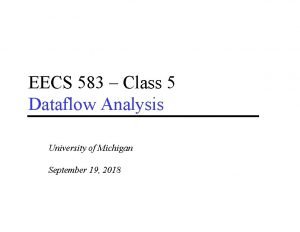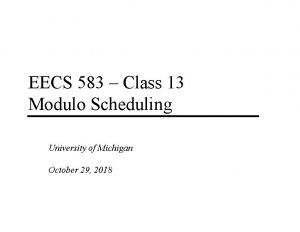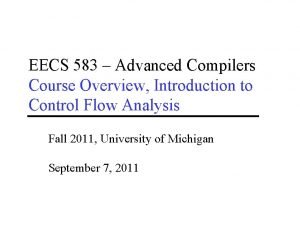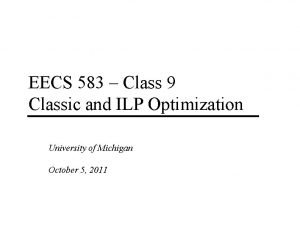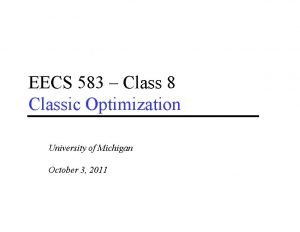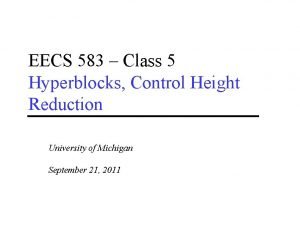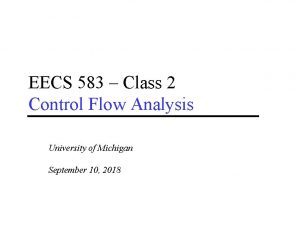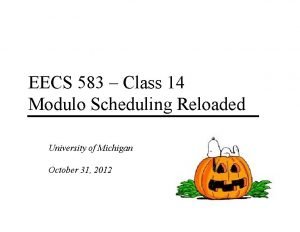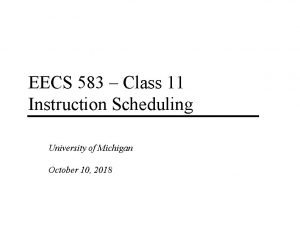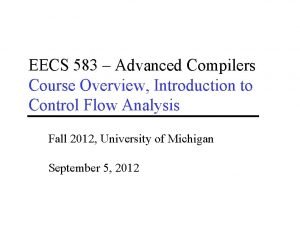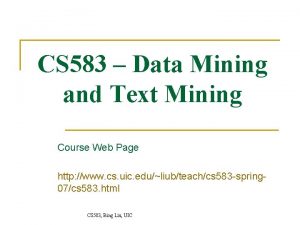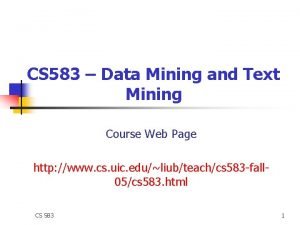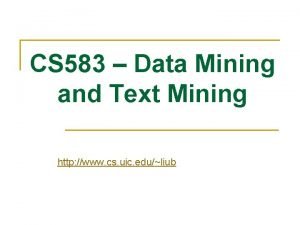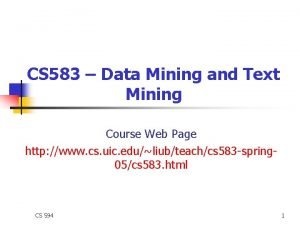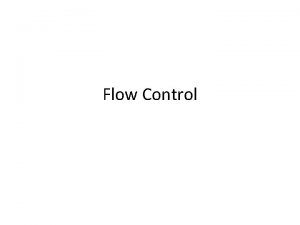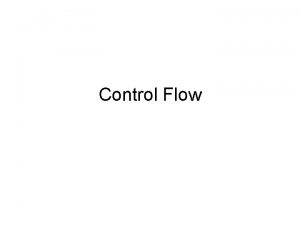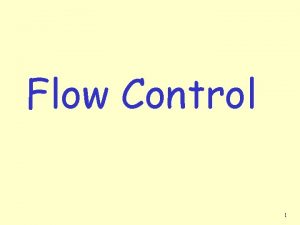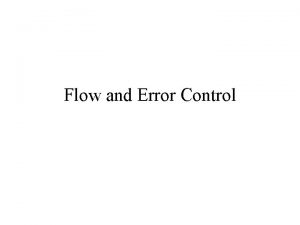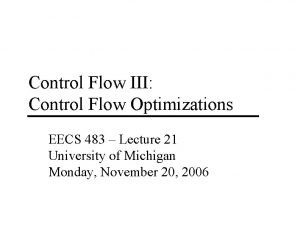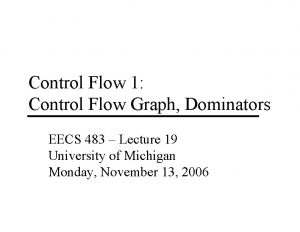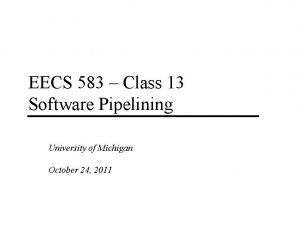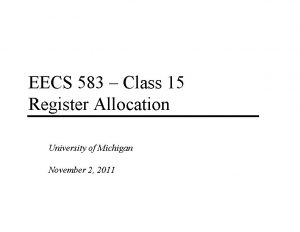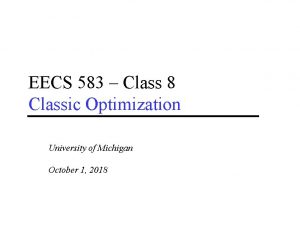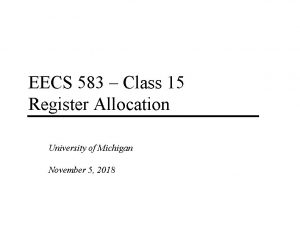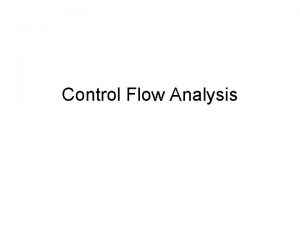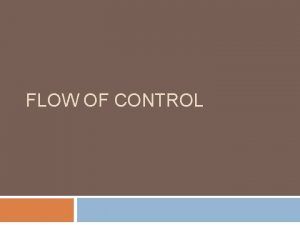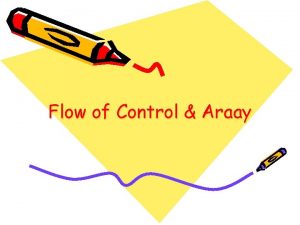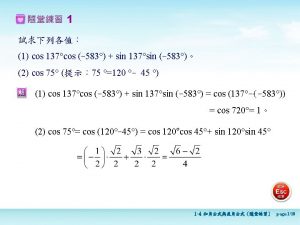EECS 583 Class 2 Control Flow Analysis University





























- Slides: 29

EECS 583 – Class 2 Control Flow Analysis University of Michigan September 10, 2018

Announcements & Reading Material v eecs 583 a, eecs 583 b. eecs. umich. edu servers are ready » Everyone has home directory and login v HW 0 – Nominally due on Wednes, but nothing to turn in » Please get this done ASAP, talk to Ze if you have problems » Needed for HW 1 which goes out on Wednes v Reading » Today’s class Ÿ Ch 9. 4, 10. 4 (6. 6, 9. 6) from Compilers: Principles, Techniques Tools Ed 1 (Ed 2) Ÿ “Trace Selection for Compiling Large C Applications to Microcode”, Chang and Hwu, MICRO-21, 1988. » Next class Ÿ “The Superblock: An Effective Technique for VLIW and Superscalar Compilation”, Hwu et al. , Journal of Supercomputing, 1993 -1 -

From Last Time: Dominator (DOM) v v Defn: Dominator – Given a CFG(V, E, Entry, Exit), a node x dominates a node y, if every path from the Entry block to y contains x 3 properties of dominators » Each BB dominates itself » If x dominates y, and y dominates z, then x dominates z » If x dominates z and y dominates z, then either x dominates y or y dominates x v Intuition » Given some BB, which blocks are guaranteed to have executed prior to executing the BB -2 -

Dominator Analysis v v Compute dom(BBi) = set of BBs that dominate BBi Initialization » Dom(entry) = entry » Dom(everything else) = all nodes v Entry BB 1 BB 2 Iterative computation BB 4 » while change, do Ÿ change = false Ÿ for each BB (except the entry BB) u u BB 3 tmp(BB) = BB + {intersect of Dom of all predecessor BB’s} if (tmp(BB) != dom(BB)) dom(BB) = tmp(BB) change = true -3 - BB 5 BB 6 BB 7 Exit

Immediate Dominator v Defn: Immediate dominator (idom) – Each node n has a unique immediate dominator m that is the last dominator of n on any path from the initial node to n Entry BB 1 BB 2 BB 3 BB 4 » Closest node that dominates BB 5 BB 6 BB 7 Exit -4 -

Dominator Tree BB 1 2 3 4 First BB is the root node, each node dominates all of its descendants DOM 1 1, 2 1, 3 1, 4 BB 5 6 7 DOM 1, 4, 5 1, 4, 6 1, 4, 7 BB 1 BB 2 BB 3 BB 4 BB 5 BB 1 BB 2 BB 6 BB 3 BB 4 BB 5 BB 6 BB 7 Dom tree -5 - BB 7

Class Problem Draw the dominator tree for the following CFG Entry BB 1 BB 2 BB 4 BB 3 BB 5 BB 7 BB 8 Exit -6 - BB 6

Post Dominator (PDOM) v v v Reverse of dominator Defn: Post Dominator – Given a CFG(V, E, Entry, Exit), a node x post dominates a node y, if every path from y to the Exit contains x Intuition v » Pdom(exit) = exit » Pdom(everything else) = all nodes v Iterative computation » while change, do Ÿ change = false Ÿ for each BB (except the exit BB) » Given some BB, which blocks are guaranteed to have executed after executing the BB v Initialization u u pdom(BBi) = set of BBs that post dominate BBi -7 - tmp(BB) = BB + {intersect of pdom of all successor BB’s} if (tmp(BB) != pdom(BB)) pdom(BB) = tmp(BB) change = true

Post Dominator Examples Entry BB 2 BB 1 BB 3 BB 4 Exit BB 5 BB 6 BB 7 Exit -8 -

Immediate Post Dominator v Defn: Immediate post dominator (ipdom) – Each node n has a unique immediate post dominator m that is the first post dominator of n on any path from n to the Exit Entry BB 1 BB 2 BB 3 BB 4 » Closest node that post dominates » First breadth-first successor that post dominates a node BB 5 BB 6 BB 7 Exit -9 -

Why Do We Care About Dominators? v v Loop detection – next subject Dominator Entry » Guaranteed to execute before » Redundant computation – an op is redundant if it is computed in a dominating BB » Most global optimizations use dominance info v BB 1 BB 2 BB 4 Post dominator » Guaranteed to execute after » Make a guess (ie 2 pointers do not point to the same locn) » Check they really do not point to one another in the post dominating BB BB 3 BB 5 BB 6 BB 7 Exit - 10 -

Natural Loops v Cycle suitable for optimization » Discuss optimizations later v 2 properties » Single entry point called the header Ÿ Header dominates all blocks in the loop » Must be one way to iterate the loop (ie at least 1 path back to the header from within the loop) called a backedge v Backedge detection » Edge, x y where the target (y) dominates the source (x) - 11 -

Backedge Example Entry BB 1 BB 2 BB 3 BB 4 BB 5 BB 6 Exit - 12 -

Loop Detection v v Identify all backedges using Dom info Each backedge (x y) defines a loop » Loop header is the backedge target (y) » Loop BB – basic blocks that comprise the loop Ÿ All predecessor blocks of x for which control can reach x without going through y are in the loop v Merge loops with the same header » I. e. , a loop with 2 continues » Loop. Backedge = Loop. Backedge 1 + Loop. Backedge 2 » Loop. BB = Loop. BB 1 + Loop. BB 2 v Important property » Header dominates all Loop. BB - 13 -

Loop Detection Example Entry BB 1 BB 2 BB 3 BB 4 BB 5 BB 6 Exit - 14 -

Important Parts of a Loop v v v Header, Loop. BB Backedges, Backedge. BB Exitedges, Exit. BB » For each Loop. BB, examine each outgoing edge » If the edge is to a BB not in Loop. BB, then its an exit v Preheader (Preloop) » » New block before the header (falls through to header) Whenever you invoke the loop, preheader executed Whenever you iterate the loop, preheader NOT executed All edges entering header Ÿ Backedges – no change Ÿ All others, retarget to preheader v Postheader (Postloop) - analogous - 15 -

Find the Preheaders for each Loop Entry BB 1 BB 2 BB 3 BB 4 ? ? BB 5 BB 6 Exit - 16 -

Characteristics of a Loop v Nesting (generally within a procedure scope) » Inner loop – Loop with no loops contained within it » Outer loop – Loop contained within no other loops » Nesting depth Ÿ depth(outer loop) = 1 Ÿ depth = depth(parent or containing loop) + 1 v Trip count (average trip count) » How many times (on average) does the loop iterate » for (I=0; I<100; I++) trip count = 100 » With profile info: Ÿ Ave trip count = weight(header) / weight(preheader) - 17 -

Trip Count Calculation Example Entry BB 1 20 BB 2 Calculate the trip counts for all the loops in the graph 360 BB 3 2100 600 480 BB 4 1100 BB 5 360 1340 BB 6 20 Exit - 18 - 1000 140

Reducible Flow Graphs v A flow graph is reducible if and only if we can partition the edges into 2 disjoint groups often called forward and back edges with the following properties » The forward edges form an acyclic graph in which every node can be reached from the Entry » The back edges consist only of edges whose destinations dominate their sources v More simply – Take a CFG, remove all the backedges (x y where y dominates x), you should have a connected, acyclic graph bb 1 Non-reducible! bb 2 - 19 - bb 3

Regions v Region: A collection of operations that are treated as a single unit by the compiler » Examples Ÿ Basic block Ÿ Procedure Ÿ Body of a loop » Properties Ÿ Connected subgraph of operations Ÿ Control flow is the key parameter that defines regions Ÿ Hierarchically organized v Problem » Basic blocks are too small (3 -5 operations) Ÿ Hard to extract sufficient parallelism » Procedure control flow too complex for many compiler xforms Ÿ Plus only parts of a procedure are important (90/10 rule) - 20 -

Regions (2) v Want » » v Intermediate sized regions with simple control flow Bigger basic blocks would be ideal !! Separate important code from less important Optimize frequently executed code at the expense of the rest Solution » » Define new region types that consist of multiple BBs Profile information used in the identification Sequential control flow (sorta) Pretend the regions are basic blocks - 21 -

Region Type 1 - Trace v Trace - Linear collection of basic blocks that tend to execute in sequence 10 BB 1 » “Likely control flow path” » Acyclic (outer backedge ok) v v 90 80 20 Side entrance – branch into the middle of a trace Side exit – branch out of the middle of a trace Compilation strategy BB 2 BB 3 80 20 » Compile assuming path occurs 100% of the time » Patch up side entrances and exits afterwards BB 5 BB 4 10 90 10 BB 6 Motivated by scheduling (i. e. , trace scheduling) 10 - 22 -

Linearizing a Trace 10 (entry count) BB 1 20 (side exit) 80 90 (entry/ exit count) BB 2 80 BB 3 20 (side entrance) BB 4 10 (side exit) BB 5 90 BB 6 10 (side entrance) 10 (exit count) - 23 -

Intelligent Trace Layout for Icache Performance BB 1 BB 2 Intraprocedural code placement Procedure positioning Procedure splitting trace 1 trace 2 BB 4 BB 6 trace 3 BB 3 The rest BB 5 Procedure view Trace view - 24 -

Issues With Selecting Traces v Acyclic 10 » Cannot go past a backedge v BB 1 Trace length 90 » Longer = better ? » Not always ! v On-trace / off-trace transitions » Maximize on-trace » Minimize off-trace » Compile assuming on-trace is 100% (ie single BB) » Penalty for off-trace v 80 20 BB 2 BB 3 80 20 BB 4 10 BB 5 90 10 Tradeoff (heuristic) BB 6 » Length » Likelihood remain within the trace 10 - 25 -

Trace Selection Algorithm i = 0; mark all BBs unvisited while (there are unvisited nodes) do seed = unvisited BB with largest execution freq trace[i] += seed mark seed visited current = seed /* Grow trace forward */ while (1) do next = best_successor_of(current) if (next == 0) then break trace[i] += next mark next visited current = next endwhile /* Grow trace backward analogously */ i++ endwhile - 26 -

Best Successor/Predecessor v Node weight vs edge weight best_successor_of(BB) e = control flow edge with highest probability leaving BB if (e is a backedge) then return 0 endif if (probability(e) <= THRESHOLD) then return 0 endif d = destination of e if (d is visited) then return 0 endif return d end procedure » edge more accurate v THRESHOLD » controls off-trace probability » 60 -70% found best v Notes on this algorithm » BB only allowed in 1 trace » Cumulative probability ignored » Min weight for seed to be chose (ie executed 100 times) - 27 -

Class Problems Find the traces. Assume a threshold probability of 60%. 100 BB 1 60 BB 2 50 BB 3 10 BB 4 20 40 5 135 BB 6 25 15 100 BB 7 25 BB 3 20 80 BB 4 BB 5 10 49 BB 6 41 75 BB 8 BB 2 51 35 80 450 BB 7 49 BB 8 100 41 10 BB 9 - 28 -
 Eecs 583
Eecs 583 Mii umich
Mii umich Eecs 583 umich
Eecs 583 umich Eecs583
Eecs583 Eecs583
Eecs583 Eecs 583
Eecs 583 Eecs 583
Eecs 583 Mrt step 6
Mrt step 6 Eecs 583
Eecs 583 Eecs 583
Eecs 583 Data flow vs control flow
Data flow vs control flow Control flow and data flow computers
Control flow and data flow computers Transaction flow graph
Transaction flow graph Stock control e flow control
Stock control e flow control Flow control and error control
Flow control and error control Resolución 583 de 2018
Resolución 583 de 2018 Digital image processing
Digital image processing Cs 583 uic
Cs 583 uic Seo931
Seo931 583 frum
583 frum Cs 583
Cs 583 Cs 583
Cs 583 Cs 583
Cs 583 Air entrainment nebulizer
Air entrainment nebulizer Cylinder oxygen
Cylinder oxygen Fraction of inspired oxygen
Fraction of inspired oxygen Laminar flow and turbulent flow definition
Laminar flow and turbulent flow definition Internal flow vs external flow
Internal flow vs external flow Flow energy review
Flow energy review Flow of energy vs flow of matter
Flow of energy vs flow of matter
